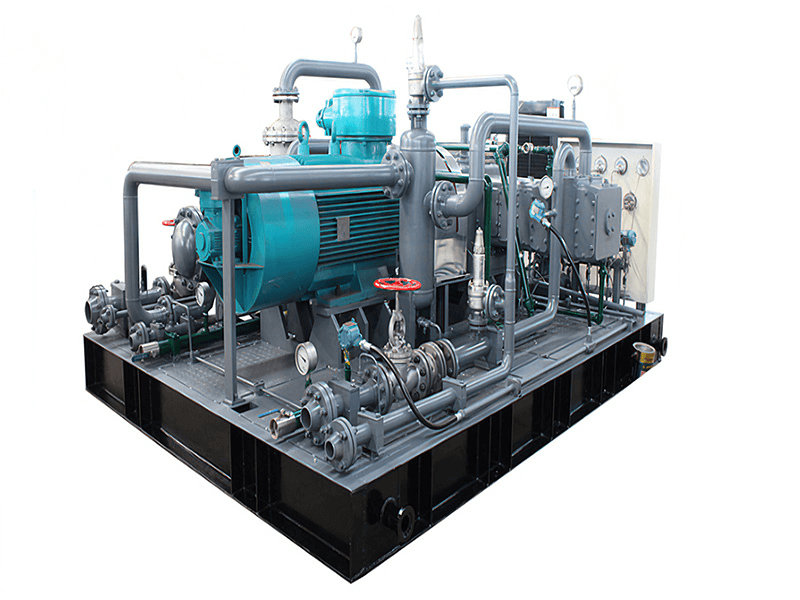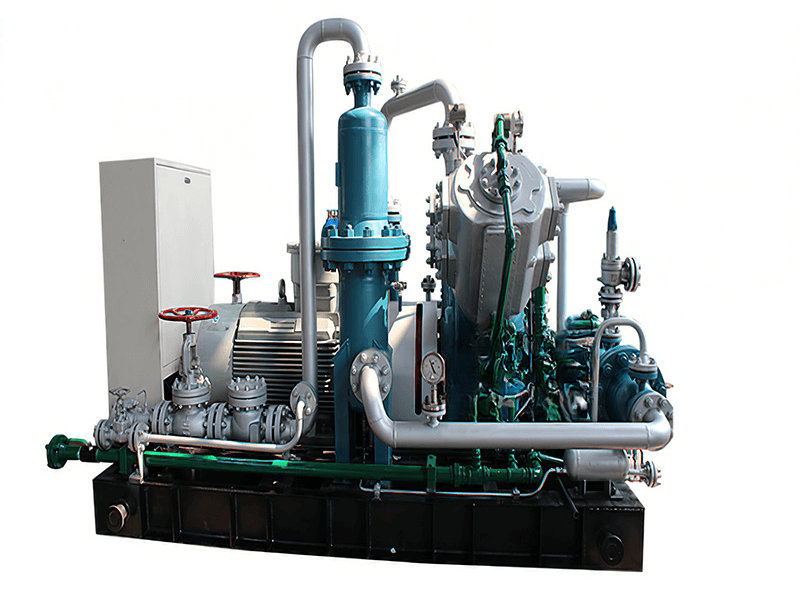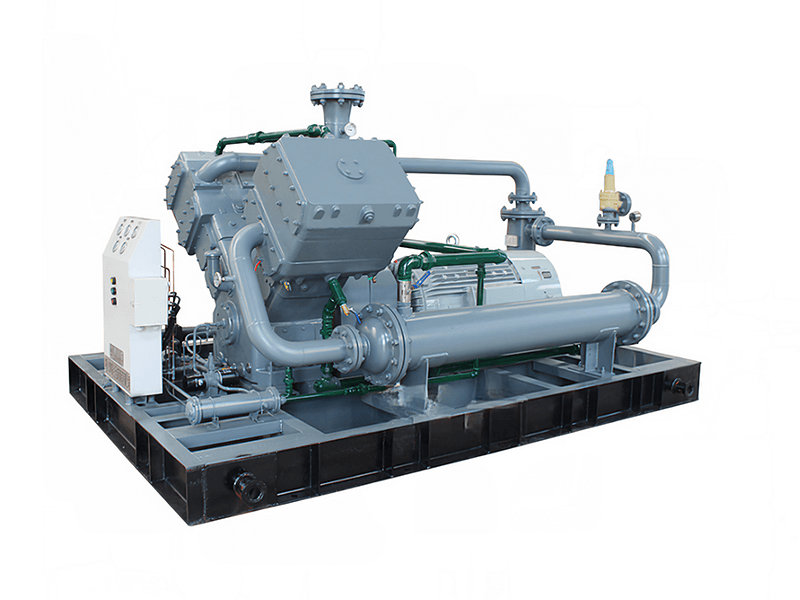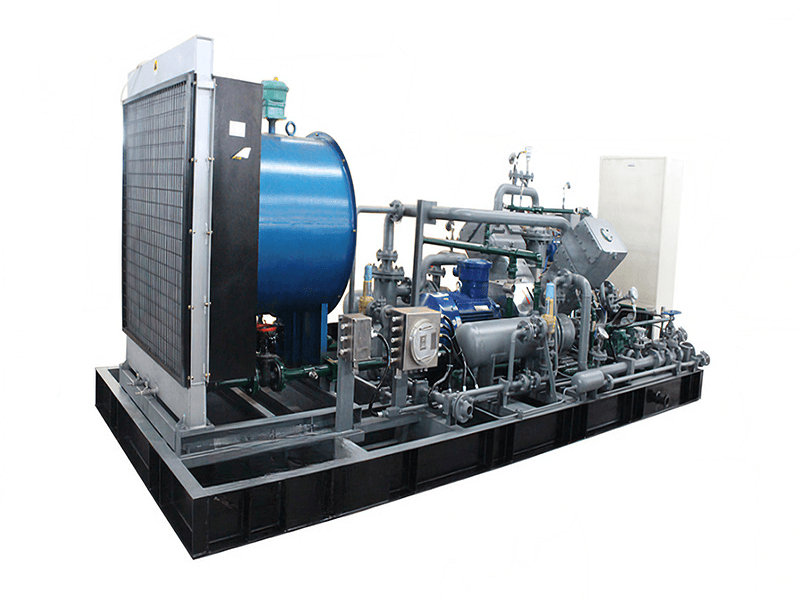Under the background of global warming, carbon dioxide capture and storage (CCS) technology is regarded as an important path to achieve the goal of carbon neutrality. In the whole chain of CCS, the compression and transportation of CO2 directly determines the economy and reliability of the system. Piston compressors are the core equipment for CO₂ compression in CCS projects due to their high pressure ratio and ability to adapt to complex working conditions. However, the physical and chemical characteristics of CO₂ (e.g., strong corrosivity, phase sensitivity) pose unique challenges to piston compressors. This paper discusses the key technologies and practical experiences of piston compressors in CCS, combining technical difficulties with typical engineering cases at home and abroad.
I. Technical Challenges of CO₂ Compression in CCS
1. Material corrosion and lifetime issues
CO₂ is easy to combine with moisture to form carbonic acid (H₂CO₃) under high pressure, which causes electrochemical corrosion on metal parts. Especially in the capture process, the residual SO₂, NOx and other acidic impurities in the flue gas will exacerbate the corrosion rate, resulting in shortening the life of core components such as cylinders and valves.
2. Phase control and thermodynamic stability
CO₂ critical point of 7.38MPa, 31.1 ℃, the compression process needs to avoid the liquid CO₂ vaporization (cause cavitation) or the formation of dry ice at too low a temperature (leading to equipment clogging). The cooling parameters between stages of multi-stage compression need to be precisely controlled.
3. Sealing and leakage risks
Supercritical CO₂ molecular diameter is small and permeability is strong, traditional sealing materials are easy to fail, leakage may lead to asphyxiation risk. In addition, the dynamic sealing performance of the stuffing box is tested under high pressure conditions.
4. Energy consumption and economic bottlenecks
CCS projects are highly cost-sensitive, with compressor energy consumption accounting for 15% to 30% of the total cost. It is necessary to optimize the structure and intelligent control to reduce power consumption and improve the system economy.
II. Key Technology Breakthrough Direction
1. Corrosion-resistant materials and surface strengthening technology
Substrate material upgrading: Duplex stainless steel (such as S32750), nickel-based alloy (Inconel 718) or titanium alloy to resist acid corrosion.
Surface coating process: Piston rod and cylinder inner wall apply plasma sprayed chromium carbide (Cr₃C₂) or diamond-like (DLC) coating, hardness increased by more than 3 times.
Non-metallic sealing innovation: the use of perfluoroether rubber (FFKM) or graphite-polyimide composites, resistant to CO₂ infiltration and high temperature and high pressure environments.
2. Multi-stage compression and dynamic cooling system
Optimization of the number of stages: design 4~6 stages compression, single stage compression ratio ≤2.5, avoiding local temperature rise over 150℃.
Intelligent cooling control: plate heat exchanger and frequency conversion cooling fan are used between stages to adjust cooling water flow according to the real-time temperature to ensure that CO₂ is in supercritical state.
3. Leakage monitoring and safety protection
Multi-sensor integration: CO₂ concentration sensors, acoustic emission probes and vibration sensors are arranged at key locations such as compressor outlets and bearing seats.
Dual redundant sealing system: the main seal adopts the combination of “metal bellows + graphite ring”, and the backup seal is equipped with a hydraulic compensation device, with a leakage rate of ≤50ppm.
4. Energy efficiency optimization technology
Variable speed drive: permanent magnet synchronous motor with vector control frequency converter, so that the compressor in the 30% ~ 110% load zone efficiency to maintain more than 85%.
Waste heat recovery: The heat of inter-stage cooling is used for amine liquid regeneration or district heating, which improves the comprehensive energy efficiency by 10%~15%.

III. Engineering Practice Case Study
Case 1: Sleipner project in Norway - the world's first commercial-scale subsea CO₂ storage
Background: Storage of 1 million tons of CO₂ per year, delivery pressure of 15MPa, operating temperature of 40℃.
Challenge: The subsea environment requires high equipment reliability and the need to prevent pipeline clogging due to CO₂ phase change.
Solution:
A three-stage piston compressor is used, with hard chrome-plated cylinder walls and carbon fiber-reinforced PEEK piston rings.
Titanium alloy plate heat exchanger is used for inter-stage cooling, and the seawater cooling temperature is stabilized at 5~10℃.
Equipped with online corrosion monitoring system, the deviation of ultrasonic thickness measurement is <0.1mm per quarter.
Effectiveness: 20 years of continuous operation, cumulative storage of more than 20 million tons of CO₂, equipment availability > 99%.
Case 2: CCS Demonstration Project for China Resources SITC Power Plant
Background: The first full-flow CCS project in China for a coal-fired power plant, capturing 100,000 tons of CO₂ per year.
Challenge: SO₂ content in flue gas up to 200ppm and frequent pressure fluctuations (0.5~2.5MPa).
Technological innovation:
Pre-purification unit: Integrated amine desulfurization and Pressure Swing Adsorption (PSA) dehydration, CO₂ purity increased to 99.5%.
Adaptive Valve Design: Adjustable valve spring stiffness, automatic adjustment of opening and closing time according to inlet pressure, reducing the risk of liquid shock.
Digital twin O&M: Compressor 3D modeling, real-time mapping of vibration and temperature data, >90% failure prediction accuracy.
Benefit: Energy consumption per unit of CO₂ compression is reduced to 0.12kWh/kg, 20% below the industry average.
Case 3: Canada Boundary Dam Carbon Capture Project
Background: The world's largest coal-fired power plant CCS project, CO₂ is used to drive oil, delivery pressure 20MPa.
Challenge: Frequent startups and shutdowns (average annual number of startups and shutdowns >200) lead to mechanical fatigue and seal failure.
Solution:
Modular design: four 3MW piston compressors connected in parallel, supporting independent overhaul of a single machine and reducing maintenance time by 40%.
Low inertia crankshaft system: crankshaft mass is reduced by 15%, together with hydraulic shock absorbers, start-stop impact is reduced by 60%.
AI Early Warning Platform: Train neural network based on historical data, predict valve failure 7 days in advance, and 100% timely replacement of spare parts.
Achievements: annual operating hours reached 8,000 hours, driving oil production increased by 150,000 barrels of crude oil/year.
IV. Industry Challenges and Response Strategies
1. Long-cycle operation in a highly corrosive environment
Countermeasures: Develop a database of corrosion-resistant materials and establish a “material-environment-life” mapping model to guide material selection and optimization.
2. Demand for economic improvement
Countermeasure: Promote standardized compression module, and reduce manufacturing cost by more than 30% through large-scale production.
3. Adaptability to complex working conditions
Countermeasure: Develop multi-objective optimization algorithms, balance pressure, temperature and energy consumption parameters, and dynamically adjust operation strategies.
V. Future Development Trends
Ultra-high-pressure compression technology: R&D of 30MPa-class compressor to support deep-sea sequestration and thick oil extraction needs.
Green power drive and energy storage integration: build “photovoltaic + compression + gas storage” integrated zero-carbon booster station.
Hydrogen-CO₂ hybrid transportation: Explore solutions for hydrogen embrittlement and sealing compatibility of materials under hydrogen doping conditions.
Intelligent operation and maintenance system: Relying on 5G and edge computing, realize remote diagnosis and autonomous decision-making for compressor groups.
Conclusion
Piston compressor is the core task of CO₂ pressurization and transportation in CCS, and its technological breakthrough needs to be centered on corrosion-resistant materials, phase control and intelligent operation and maintenance. Successful practices in projects such as Sleipner in Norway and SITC in China have shown that piston compressors are able to meet the requirements of high reliability and economy in CCS projects through material innovation, optimization of multi-stage cooling and integration of digital technology. In the future, with the deep combination of UHP technology and renewable energy, piston compressors will play a more critical role in the global carbon emission reduction system.

























